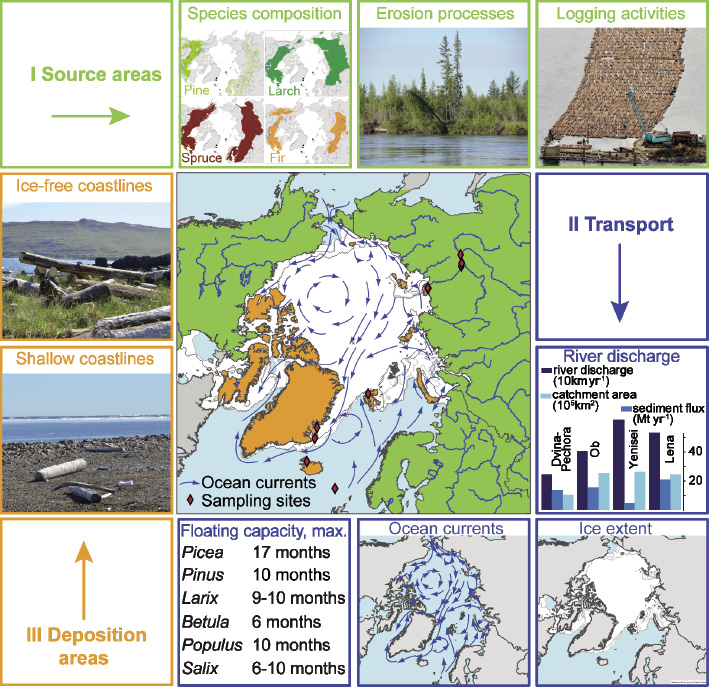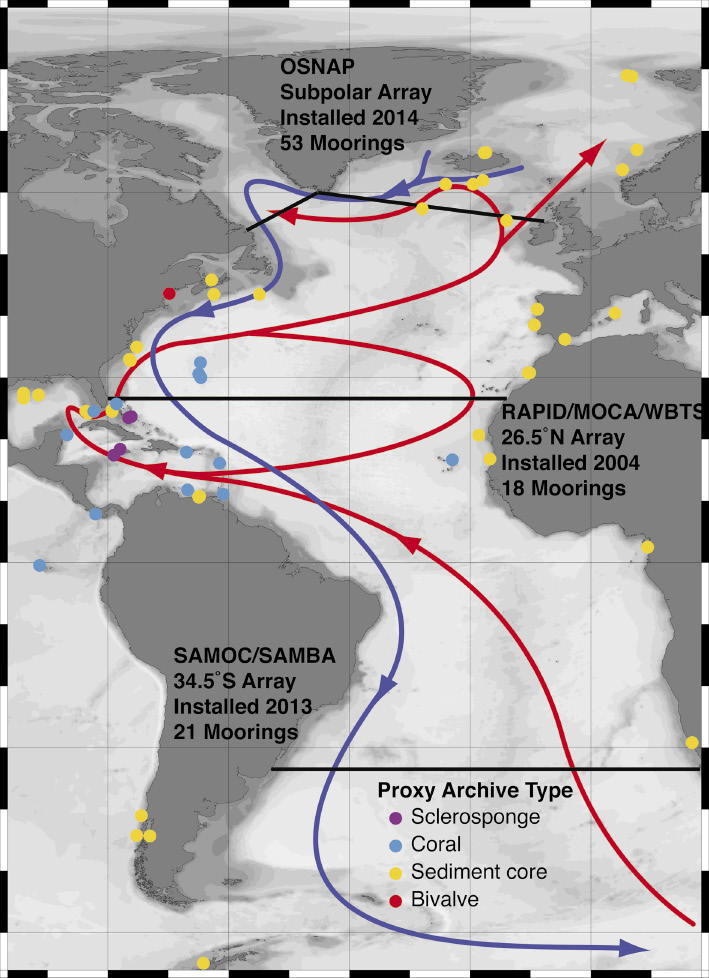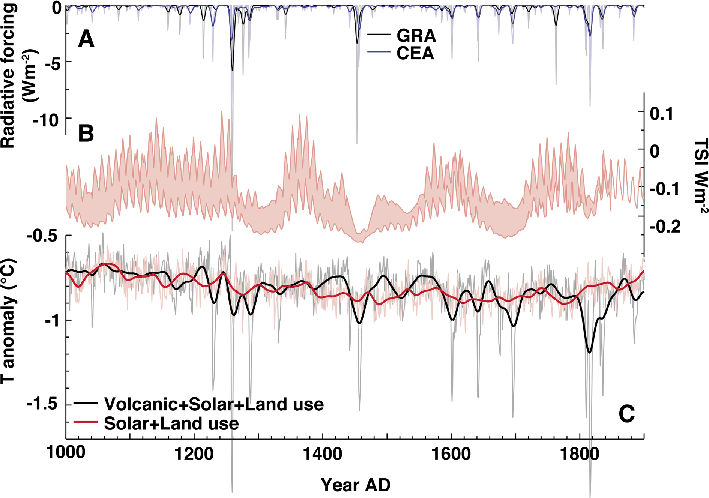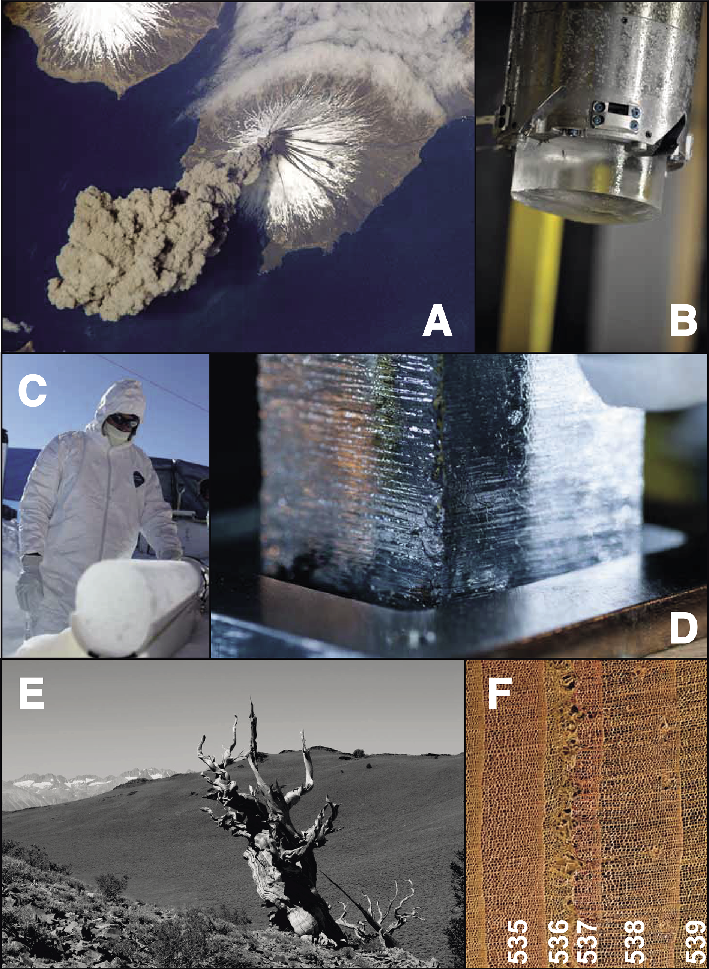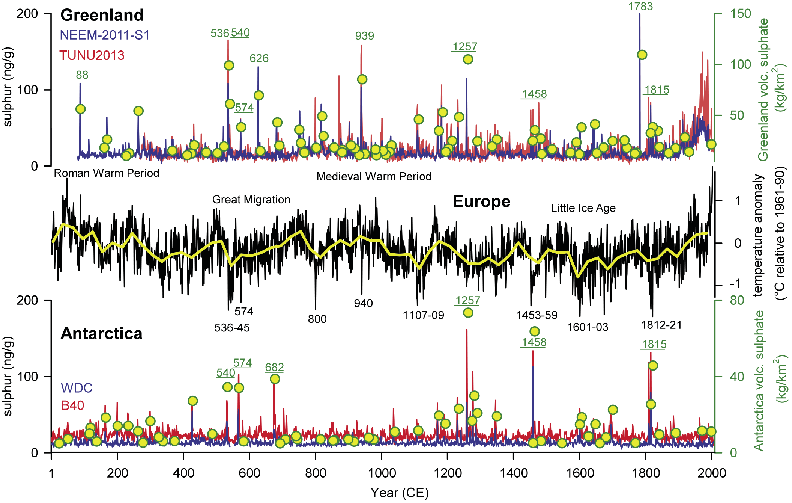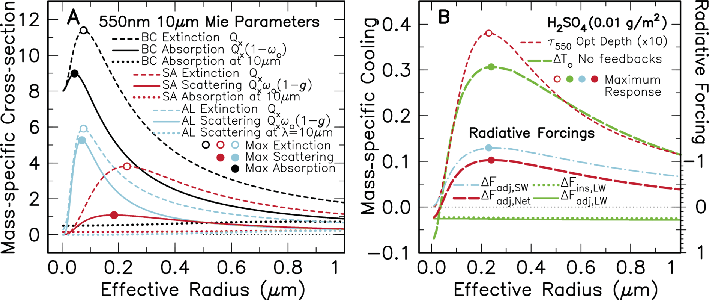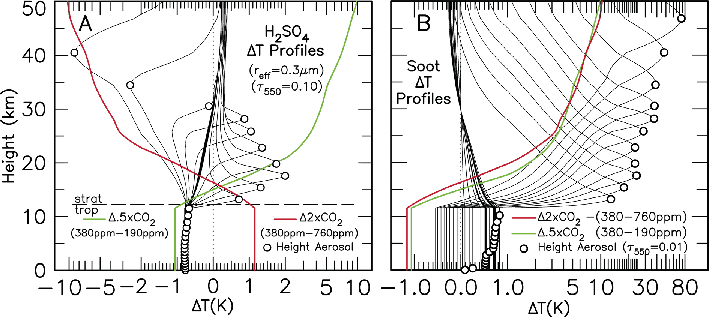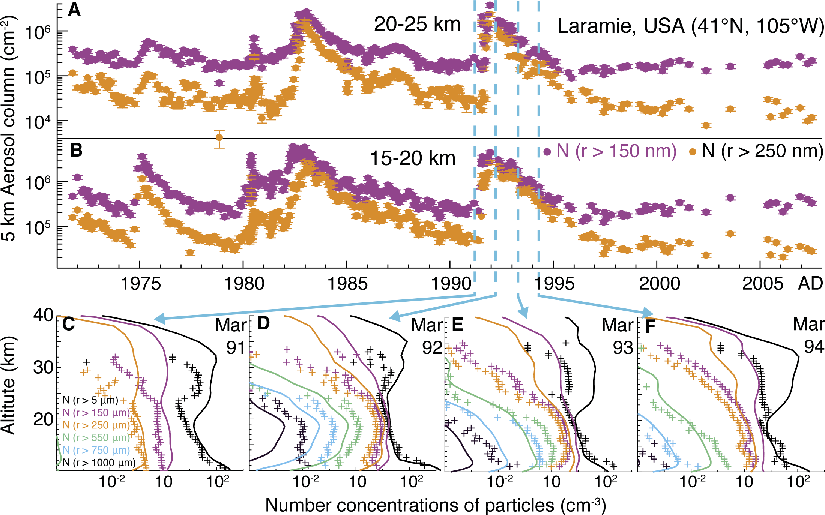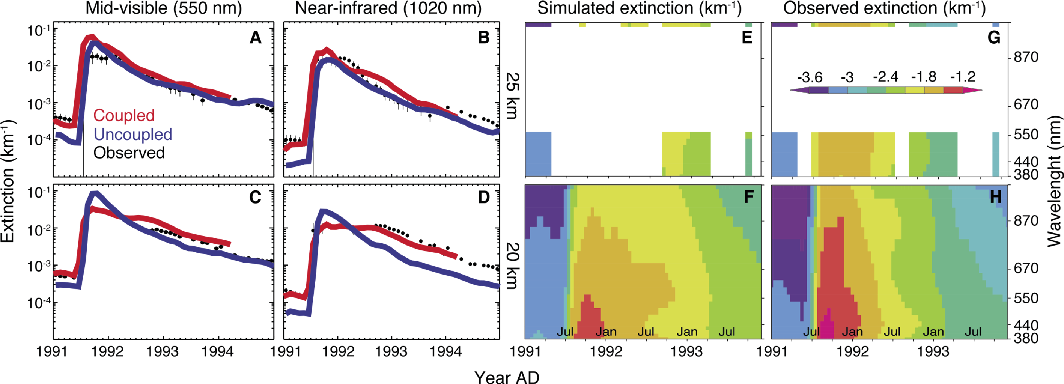- Home
- Taxonomy
- Term
- PAGES Magazine Articles
PAGES Magazine articles
Publications
PAGES Magazine articles
2016
Past Global Changes Magazine
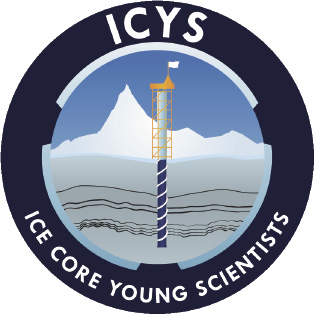 |
Pascal Bohleber1, M. Cavitte2, B. Koffman3, B. Markle4, P. Pavlova5, M. Winstrup6 and H. Winton7
Hobart, Australia, 6 March 2016
Ice Core Young Scientists (ICYS) held a highly successful one-day workshop for early-career researchers (ECRs) in conjunction with the IPICS 2016 conference in Hobart, Australia. Over 85 ECRs attended the event, equivalent to about 40% of the IPICS conference delegation. In addition to providing professional development, the workshop offered a chance for ECRs to get to know each other before the week-long conference began.
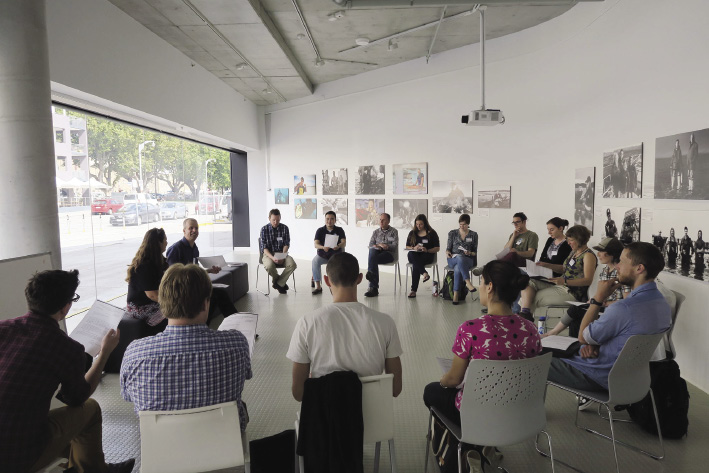 |
|
Figure 1: Discussion group “science, family and equality: negotiating the ECR career path”. |
The workshop kicked off with a plenary lecture by Nerilie Abram of the Australian National University, asking the question “Why do we need more paleoclimate records from Antarctica?” Nerilie presented research currently in preparation by the PAGES 2k Network, showing that climate models currently do not accurately represent the climate in the Southern Hemisphere. She argued for additional ice-core records from Antarctica and for improved integration of ice-core and other paleoclimate proxy data.
The plenary was followed by a lively panel discussion on the future of ice-core science. Eight panelists shared their views on what and where the next big ice-core project should be, and what major questions the community can try to address using ice cores in the future. Major themes coming out of the discussion included: (a) integrating data from multiple ice cores, such as the work by the PAGES Antarctica2k community; (b) filling in the latitudinal gap of paleoclimate records between the poles and taking advantage of other types of climate proxy records; (c) enhancing the interaction with climate modelers, oceanographers, and biologists using ice cores to answer non-climate questions; and (d) advancing technologies, such as rapid-access drilling and in situ analysis down boreholes. Major questions centered on improving predictions for future climate, especially in regard to sea-level rise, and understanding the role of Antarctica in the climate system. During the IPICS conference closing session, ICYS provided the broader ice-core community with an ECR perspective on the future of ice-core science.
The ICYS workshop included breakout discussions focused on topics of great importance to ECRs, but which are rarely taught in formal settings. Session topics included “How to get your research funded as an ECR”, “Leadership techniques and being a principal investigator” and “Initiating international collaborations”. Each breakout group was facilitated by a mid-career scientist who shared his or her expertise and experience in these areas. We were also lucky to have Michael White, an editor at Nature, discuss issues around authorship.
Our final plenary session was facilitated by Heidi Roop, of the Science and Society research group at Victoria University of Wellington, New Zealand. Heidi shared insights on how to communicate more effectively with the public. We learned that “knowledge building” efforts, such as having community meetings and developing citizen science initiatives, are most effective in getting the public to understand, appreciate, support, and critically become involved with the science we do. We were able to fold these ideas into short outreach videos, called FrostBytes, which were produced at the end of the workshop. They will serve as a valuable resource for outreach and engagement, and are publicly available on the Climate and Cryosphere (CLiC) website.
PAGES generously supported six travel packages for ECRs from developing countries to attend the workshop. Travel support for ECR attendees was also provided by the US National Science Foundation, the IPICS 2016 conference sponsors, the EPICA Descartes Prize, and the West Antarctic Ice Sheet Divide ice core program. Lunch was kindly supported by CLiC.
This workshop, the first of its kind, successfully built a more cohesive international community of ECRs in ice-core sciences and provided those researchers with information and skills useful to their developing careers – the primary goals of ICYS. Many attendees remarked that simply meeting fellow ECRs before the main meeting improved their conference experience and sense of involvement in the community.
affiliationS
1Climate Change Institute, University of Maine, Orono, USA
2Institute for Geophysics, University of Texas at Austin, USA
3Department of Earth Sciences, Dartmouth College, Hanover, USA
4Earth & Space Sciences, University of Washington, Seattle, USA
5Paul Scherrer Institut, Villigen, Switzerland
6Centre for Ice and Climate, University of Copenhagen, Denmark
7British Antarctic Survey, Cambridge, United Kingdom
contact
ICYS Executive Committee: icecoreys gmail.com
gmail.com
Publications
PAGES Magazine articles
2016
Past Global Changes Magazine
Lena Hellmann1,2, Ó. Eggertsson3 and U. Büntgen1,2,4
Mógilsá, Iceland, 27-30 April 2016
This workshop, on the use of Arctic driftwood as an interdisciplinary paleoenvironmental proxy, was held at the Icelandic Forest Research Institute Mógilsá, northwest of Reykjavik. Twenty-one participants from 10 European and North American countries brought expertise in dendro-sciences, paleoclimatology and paleoecology, as well as archeology, history, oceanography and radiocarbon dating. The aim of the meeting was to build up a driftwood research network, by (1) the organization and coordination of future fieldwork, (2) the joining of forces towards a cross-disciplinary review paper, and (3) the collection of ideas for fundraising and proposal writing to facilitate international collaboration.
A first session on dendro-sciences and paleoecology provided an overview on the achievements of driftwood provenancing and dating, and its potential for reconstructing ocean-current dynamics and sea-ice variations. A second session reviewed proxy-based climate reconstructions for the Arctic, using examples of archeological driftwood research on the effects of wood decaying fungi to ancient wood use and tree-ring dating of archeological driftwood remains. A third session was dedicated to the reconstruction of relative sea-level changes, the effects of shrinking sea ice, the use of paleo-climatic estimates to constrain future climate predictions, as well as the current progress in radiocarbon dating.
Discussions emphasized the urgent need for cross-national sample exchange and free data access.
Finally, all participants agreed on writing an interdisciplinary review article about the current status and future perspective of Arctic driftwood research. The review paper is motivated by the high sensitivity of the Arctic to even small climatic changes going along with short instrumental measurements and a sparse proxy-data coverage for the high-northern latitudes, which again constrains model predictions. Knowledge on past variations in sea-ice extent, ocean-current dynamics, relative sea-level change, biotic dispersal, transport times within the Arctic Ocean and the importance of driftwood for human settlements is scarce.
Figure 1 illustrates the complexity of the driftwood system and proves the relevance of an interdisciplinary research avenue. Arctic driftwood is a unique integral that combines various fields of research within the Arctic region by representing an easily accessible and relatively cheap environmental archive with a huge unused potential that needs to be explored. Existing methods and material from different disciplines of Arctic driftwood research will be provided in the review paper to show the potential of more reliable reconstructions extending prior to the period of instrumental measurements. This paper will further propose the need for Arctic driftwood as a cross-disciplinary proxy archive that can be used to supplement long-term observations and model simulations. The outlook will set priorities for future driftwood fieldwork and research activities, and promote Arctic driftwood as a contribution to multi-proxy approaches for a better understanding of past and present characteristics of the Arctic system.
The workshop created a new strong network of researchers working with this unique proxy archive that will be relevant for the PAGES initiative also in the future. A follow-up meeting on Arctic driftwood research has already been scheduled for May 2017.
affiliationS
1Swiss Federal Research Institute, WSL, Birmensdorf, Switzerland
2Oeschger Centre for Climate Change Research, Bern, Switzerland
3Iceland Forest Service Mógilsá, Reykjavik, Iceland
4Global Change Research Centre AS CR, Brno, Czech Republic
contact
Lena Hellmann: lena.hellmann wsl.ch
wsl.ch
Publications
PAGES Magazine articles
2016
Past Global Changes Magazine
K. Halimeda Kilbourne
Boulder, USA, 23-25 May 2016
To make more accurate projections of future climate, we must improve our understanding of Atlantic Meridional Overturning Circulation (AMOC), its drivers and its impacts. Modern oceanographic observations of AMOC have limited record lengths, making it difficult to address important processes with timescales of decades to centuries (Buckley and Marshall 2016). Paleoceanographic data and techniques applied to Earth’s recent past have a demonstrated potential to provide information about past AMOC behavior that could address questions about AMOC processes on these timescales and put recent changes into historical context (Alley 2007; Denton and Broecker 2008). Doing so most effectively requires coordination and cooperation across traditional disciplinary boundaries.
Two different scientific communities - modern physical oceanographers and paleoceanographers - came together to work on understanding AMOC over decades to centuries. We had approximately 60 attendees from nine countries, including 18 early-career scientists. One third of participants indicated in their meeting applications that they were working on the modern system, half were working on paleoceanographic questions, and the rest defied such simple characterization. During the meeting, it became clear the group represented four communities - modelers and observationalists working on the modern AMOC system, and modelers and observationalists working on the AMOC system of the past. Sometimes the lines were blurry, but there were clear differences in vocabulary, assumptions and scientific priorities. The discussions led to four main recommendations for progressing toward a better understanding of AMOC.
A consistent framework between models and observations
A factor limiting progress is the ability to make valid comparisons between paleoclimate data, model data and modern observations. AMOC in models is often based on the zonally integrated circulation in the Atlantic, and modern observational networks have been set up with this in mind. Paleoclimate proxy records, on the other hand, usually reconstruct an AMOC-related variable such as the vertical mixing in the Labrador Sea. Priority needs to be given to research and activities that move the communities toward a common standard for comparisons between observational and model data.
A denser network of AMOC and AMOC-related variables
Iterating between observational data and models can be a powerful tool for improving mechanistic understanding of AMOC. Observations tell us how the system behaves and models provide a tool to explore how such behavior arises. Conversely, if different models have different mechanisms, we can use observations to constrain which model might have a more-realistic simulation of the process. The last 1000 years is a key target period because of (i) relatively abundant existing paleoclimate data to provide information about background climate; (ii) reasonably constrained climate forcing variables; (iii) the availability of annual or better resolution proxy archives, and (iv) the potential to overlap with the instrumental record to provide quantitative proxy calibrations. Such data-model comparisons, requiring an improved network of proxy records guided by process-based information from models, can be used to reliably characterize the past behavior of AMOC, including the frequency and amplitude of decadal to centennial variability, as well as the response in associated environmental variables.
Improved understanding and communication of uncertainties
Cross-disciplinary coordination and cooperation could be facilitated if an effort was made to better quantify and report the uncertainties of our research. This issue came up repeatedly in reference to proxy reconstructions and calibrations, data assimilation projects, climate forcing factors used to drive models, and in data-model comparisons.
Encourage coordination between scientific communities
This may be accomplished at the level of individual researchers or larger organizations. Examples of the latter include adding a paleoceanography-specific team to the US AMOC/UK RAPID working groups; reviving something similar to the former PAGES-CLIVAR Intersections program to focus on targeted workshops; and strengthening links between CMIP and PMIP.
affiliation
Chesapeake Biological Laboratory, University of Maryland Center for Environmental Science, Solomons, USA
contact
K. Halimeda Kilbourne: kilbourn umces.edu
umces.edu
references
Alley RB (2007) Annu Rev Earth Planet Sci 35: 241-272
Publications
PAGES Magazine articles
2015
Past Global Changes Magazine
News
PAGES welcomes a new Director
In August, our Executive Director of 10 years, Thorsten Kiefer, left to pursue a role at Future Earth. An article on page 43 describes his outstanding contribution to PAGES over the past decade.
In November, we welcomed Marie-France Loutre as PAGES’ new Executive Director. Marie-France has a distinguished international career in past global change research, particularly in paleoclimate modeling and studying how different forcings and feedbacks influence climate. We also welcomed Angela Wade to the role of Communications and Project Officer.
PAGES farewells IGBP and formalizes relationships with Future Earth and WCRP
The International Geosphere-Biosphere Programme (IGBP), PAGES’ umbrella organization since its inception in 1991, will conclude in late 2015. IGBP recently published the last Global Change Magazine, reflecting on IGBP’s three-decade legacy to global change research.
Looking to the future, PAGES has now officially become a core project of Future Earth and established a scientific partnership with WCRP. Read more on page 44.
PAGES and IGBP at AGU 2015
The International Geosphere-Biosphere Programme (IGBP) will host a series of events at the 2015 AGU Fall Meeting to celebrate its past and the transition to Future Earth. PAGES working groups are well-represented in many of the IGBP co-sponsored sessions.
www.pastglobalchanges.org/calendar/all-events/127-pages/1455-agu-fall-mtng-2015
New PAGES Working Groups
Four new working groups have recently been launched:
- • Pliocene climate variability over glacial-interglacial timescales (PlioVAR)
www.pastglobalchanges.org/ini/wg/pliovar - • The PAGES-PMIP Working Group on the Quaternary Interglacials (QUIGS)
www.pastglobalchanges.org/ini/wg/quigs - • The Floods Working Group will investigate past flood events worldwide to improve our understanding of the physical processes controlling floods.
www.pastglobalchanges.org/ini/wg/floods - • Volcanic Impacts on Climate and Society (VICS) aims to improve our understanding of the impacts of volcanic forcing on climate and societies.
www.pastglobalchanges.org/ini/wg/vics
Read more about PlioVAR and QUIGS in their Program News articles in this issue or you can read more about all of the groups on our website. All PAGES working groups invite participation by interested scientists anywhere in the world.
PAGES OSM & YSM 2017
The 5th PAGES Open Science Meeting (OSM) and 3rd Young Scientists Meeting (YSM) will be held in Zaragoza, Spain. The proposed dates are around early to mid-May 2017. We look forward to organizing a rewarding and memorable meeting with our hosts, the Pyrenean Institute of Ecology, Spanish National Research Council (IPE-CSIC).
Upcoming issues of PAGES Magazine
The next issue of PAGES Magazine will be on abrupt changes and tipping points. Contact the guest editors Chris Turney (c.turney unsw.edu.au), Chris Fogwill (c.fogwill
unsw.edu.au), Chris Fogwill (c.fogwill unsw.edu.au), Tim Lenton (t.m.lenton
unsw.edu.au), Tim Lenton (t.m.lenton exeter.ac.uk) and Richard Jones (r.t.jones
exeter.ac.uk) and Richard Jones (r.t.jones ex.ac.uk), or the PAGES office to enquire about contributing to this issue.
ex.ac.uk), or the PAGES office to enquire about contributing to this issue.
We are also preparing an issue on climate change and cultural evolution, guest edited by our Scientific Steering Committee (SSC) members Claudio Latorre (clatorre bio.puc.cl), Janet Wilmshurst (Wilmshurstj
bio.puc.cl), Janet Wilmshurst (Wilmshurstj landcareresearch.co.nz), and Liping Zhou (lpzhou
landcareresearch.co.nz), and Liping Zhou (lpzhou pku.edu.cn). Contact them or the PAGES office if you are interested in contributing or exploring ideas.
pku.edu.cn). Contact them or the PAGES office if you are interested in contributing or exploring ideas.
In general, if you wish to lead a special section of the magazine on a particular topic, let us know at the PAGES office or speak with one of our SSC members.
Calendar
Climate variability during the Late Pliocene
29 February - 01 March 2016 - Leeds, UK
04 April 2016 - Chambéry, France
Modeling isotope ratios in proxy climate records
02-05 May 2016 - Friday Harbour, USA
Central and Eastern EU Paleoscience Symposium
23-24 May 2016 - Cluj-Napoca, Romania
Data and model estimates of hydroclimate
01-03 June 2016 - Palisades, USA
http://www.pastglobalchanges.org/calendar
Featured products
Already committed to 6 meters of sea-level rise?
In a recent high profile paper, Dutton et al. from PALSEA2 analyze sea-level rise due to polar ice-sheet mass loss during past warm periods (2015, Science 349).
2k Network studies
- • Ocean2k’s low resolution team found an 1800 year-long robust cooling trend in global sea surface temperatures. They linked the coolest period to an increase in volcanic eruptions (2015, Nat Geosci 8).
- • Ocean2k’s high resolution team has quadrupled the observational reach into tropical ocean temperature history (Tierney et al. 2015, Paleoceanography 30).
- • Zhang et al. address modified climate with long term memory in tree ring proxies (2015, Env Res Lett 10).
- • Wang et al. explore different techniques for climate field reconstructions (2015, Geophys Res Lett 42).
Varve research showcased
The Varves Working Group published a review of annually laminated (varved) lake sediments (Zolitschka et al. 2015, Quat Sci Rev 117).
Human-environment interactions
- • Members of PAGES have published a special issue on the challenge of quantifying past human-environment interactions (Verstraeten (Ed.) 2014, Anthropocene 8).
- • Dearing et al. present case studies combining paleorecords with conventional sources of historical information (2015, Anthropocene Rev).
- • LandCover6k members synthesize the archeological record in sub-Saharan Africa to review past land use systems (2015, Anthropocene 9).
Reconstructions and simulations
Emerging out of the PAGES 2k/PMIP 2013 workshop, Zanchettin et al. reconcile reconstructed and simulated features of the winter Pacific/North American pattern in the early 19th century (2015, Clim Past 11).
Cover
Eruption of Sarychev Peak, Matua Island, Kuril Islands, Russia
Astronauts aboard the International Space Station captured this photo of the early stages of an eruption of ash and steam from Sarychev Peak in the Kuril Islands in June of 2009. Image from the Earth Science and Remote Sensing Unit, NASA Johnson Space Center (ISS020-E-9048).
Publications

PAGES Magazine articles
2015
Past Global Changes Magazine
Hubertus Fischer1 and Alan Mix2, Co-Chairs, PAGES Scientific Steering Committee
After 10 years of extraordinary service and success with PAGES, Executive Director Thorsten Kiefer moves on to even larger challenges at the Future Earth Global Hub in Paris.
Thorsten began his scientific life as a paleoceanographer, with a PhD from the University of Kiel in 1997, followed by postdocs first in Kiel and then at University of Cambridge. While in the UK, Thorsten honed his leadership and diplomacy skills as well as a British sense of humor, all of which made his decade with PAGES, which started in 2005 when Thorsten became director of the PAGES International Project Office in Bern, both successful and fun.
2005 was a difficult year for PAGES; although the science was strong, funding was at risk. Jumping aboard, Thorsten grabbed the PAGES wheel and began to steer. His first task was to organize the 2nd Open Science Meeting (OSM) in Beijing in August 2005. Following the Beijing OSM, Thorsten organized the 2009 and 2013 OSMs in Corvallis and Goa, and in the process made this four-yearly event a bright beacon in the global paleoscience calendar. Thorsten recognized the special needs of early-career researchers, and in 2009 he successfully launched the first Young Scientists Meeting alongside the OSM in Corvallis; this innovative model is now emulated by many other projects and societies.
Having righted the ship, Thorsten’s next task was to chart a new course, guiding the development and implementation of PAGES’ new Science Structure in 2006. A clear structure of foci and cross-cutting themes became the channel through which PAGES has navigated during the last 10 years, launching 40 working groups that have yielded over 157 peer reviewed journal articles and 43 special issues. Under this structure, the PAGES community grew to more than 5,500 subscribers from 125 countries.
Yet another challenge came in the past two years, with PAGES required to change course again as its former guiding star, the International Geosphere Biosphere Program (IGBP), set and a new one rose in form of the transdisciplinary sustainability program Future Earth. Again through his steady guidance of the scientific community, Thorsten helped navigate the PAGES ship safely into this new harbor. With a newly defined science structure (pastglobalchanges.org/science/intro), and a new stronger relationship both with Future Earth and the World Climate Research Programme, PAGES is perfectly positioned to continue its leadership in paleoscience while helping to contribute to Future Earth’s goal of accelerating the transformation to sustainable practices. During the transition process, Thorsten has helped communicate the unique insights that paleoscience can bring regarding the long-term changes in the Earth system and how these can be of benefit in preparing for the future. Building on Thorsten’s legacy, PAGES will continue its tradition of openness and inclusion, and will remain a beacon that leads the world’s community of paleoscientists to meet, collaborate, and advance a coordinated agenda for globally relevant paleoscience.
In September this year, after a decade spent transforming PAGES into a polished speedboat, Thorsten moved on to assume an even larger responsibility, piloting the supertanker that is the Future Earth Global Hub in Paris. Here he will find a new chance to navigate the shallows of early program implementation and to set the course for even larger scientific vistas. For PAGES this is a great loss, but it is also a great gain. Thorsten has left PAGES with a sturdy hull and wind in its sails, and we are reassured that his deep expertise and remarkable skills will provide a steady hand on the wheel of Future Earth, and that PAGES will be well understood within the larger context.
affiliations
1Climate and Environmental Physics, University of Bern, Switzerland
2College of Earth, Ocean, and Atmospheric Sciences, Oregon State University, Corvallis USA
contact
Hubertus Fischer: hubertus.fischer climate.unibe.ch
climate.unibe.ch

Publications
PAGES Magazine articles
2015
Past Global Changes Magazine
Thorsten Kiefer1, H. Fischer2, A. Mix3, S. Fritz4, L. von Gunten5 and L. Goodwin5
PAGES has revised its scientific structure to better align with Future Earth’s philosophies of increasing interdisciplinarity and societally-relevant science. The new structure represents an integrative space between climate, environment, and humans as the key components of a sustainable Earth system.
The landscape of global change programs within which PAGES is embedded is transforming, as previous articles highlighted already (PAGES IPO 2014). The International Geosphere-Biosphere Programme (IGBP), PAGES’ umbrella organization since its inception in 1991, will conclude by the end of 2015. IGBP’s legacy and that of two other global change programmes, namely Diversitas and the International Human Dimensions Programme, will transfer to Future Earth, a large research platform for global sustainability that has been developing over the last few years.
Future Earth, subtitled “research for global sustainability”, aims to provide the knowledge and support to accelerate our transformations to a sustainable world. To reach this ambitious goal, Future Earth intends to modify the approach taken by the predecessor programs in essentially three ways: (1) by re-directing research from addressing problems towards informing solutions to pressing societal issues, (2) by increasing the level of interdisciplinarity to an inclusiveness that reaches from the physical sciences, through the biogeochemical and ecological sciences to social sciences and the humanities, and (3) by working together with societal partners who have an interest in sustainability science (stakeholders), particularly in jointly designing initial research plans and end products.
From 2016, the former four global environmental change programs will have been boiled down into two. Future Earth will be complemented by the World Climate Research Programme (WCRP), which has formed a strong partnership with Future Earth, but will otherwise continue to coordinate its own international climate research.
In the handover from IGBP to Future Earth, IGBP’s core projects, including PAGES, were invited to join the new initiative. PAGES’ Scientific Steering Committee decided that PAGES would join Future Earth as a core project, while also broadening its thematic basis by establishing a scientific partnership with WCRP. Both affiliations have been formalized over recent months.
An open theme space replaces distinct foci
Since the community consultations and plenary discussions at the PAGES Open Science Meeting in 2013 in Goa, PAGES has been preparing the terrain to successfully continue the facilitation of international scientific collaboration on past global changes, while also being able to link in with the agendas of Future Earth and WCRP.
Accordingly, PAGES has revised its scientific structure to better align with Future Earth’s philosophies of integration and societally-relevant science. PAGES’ science structure addresses the key components of the Earth system through the themes Climate, Environment, and Humans (Fig. 1). These themes define our scientific scope and reflect the holistic Earth system science approach that is becoming increasingly integrated within PAGES.
• The Climate theme represents quantitative climate system dynamics from a paleo-perspective. The aims are to improve knowledge on climate forcings, sensitivity, variability, modes, non-linearities and thresholds, Earth system feedbacks, regional-scale dynamics, and how current climate models represent the various aspects of climate dynamics.
• The Environment theme addresses components of the biosphere that interact with each other and climate, and may introduce feedbacks into the Earth system. This includes biogeochemical cycling, ecosystem dynamics, and ecosystem services.
• The Humans theme addresses long-term environmental changes where humans are a major agent, e.g. through land use, pollution, fertilization, soil erosion, river damming, or landscape fragmentation, and where environmental changes have a demonstrable effect on the functioning and well-being of ecosystem services and societies.
At first glance, the change from the previous circular structure to a triangular one might not look like a major coup. And indeed, what matters most in PAGES will remain, that our working groups are excellent, active, and productive. However, the modification of the structural geometry does actually go along with changes in emphasis and conceptual thinking within PAGES.
Replacing the four foci - climate forcings, regional climate, earth system dynamics, and human-climate-ecosystem interactions - with the cornerstones of the triangle has shifted the thematic emphasis away from its dominant climate focus towards giving more equal importance to human, environmental, and climatic impacts within the framework of fundamental Earth system science.
Another measure to streamline the structure was to deemphasize research on methods by eliminating the four former cross-cutting themes on chronology, proxies, modeling, and data management. This does not mean that methodological aspects are considered unimportant. However, research on chronology, proxies, and modeling in PAGES will need to be pursued in the context of addressing specific Earth system science questions. And the data management topic has even been identified as a matter of vital importance and has hence been further highlighted in the new structure (see Fig. 2).
The most fundamental change in philosophy reflected by the new structure might be that it eliminates the previous silo-like foci by streamlining them into themes that define a boundary-free, integrative scope. Accordingly, working groups do not need to be categorized any more as belonging to one particular focus or cross-cutting theme. Instead, the open thematic space now acknowledges and encourages that all working groups and other activities address a mixture of climatic, environmental, and human aspects. Graphically, the relative importance of those aspects places each working group in a certain region of the triangle (Fig. 2).
Finally, topics that are particularly integrative between climate, environment, and humans, are now centrally placed at the heart of PAGES rather than falling between the cracks of the former foci.
A new layer of integration across working groups
Many issues of concern to society cut across the specific topics addressed in working groups under the three new themes and will benefit from being addressed with an inclusive approach. The cross-topical integrative activities, depicted in the middle of the triangle, are thus a new format in PAGES dedicated to facilitating an additional level of scientific exchange, synthesis, and outreach. They build on the results and specialist expertise of the working groups and draw on complementary scientific expertise on modern process and future projection research from the networks of Future Earth and WCRP. Outputs are expected to provide information for impact assessments and management strategies and thus to form key contributions to the scientific agendas of Future Earth and WCRP.
At present, four integrative activities with the potential to provide transformative advances in approaches to paleoscience have been identified:
• Data stewardship: PAGES aims to develop sets of best practice guidelines for data standards, archiving, and access. This will be done by soliciting broad input from the international community of experts.
• Warm worlds: As the instrumental record fails to provide estimates related to future scenarios of a world that will be warmer than today by several degrees, PAGES aims to synthesize evidence for global and regional changes in the Earth system associated with warmer periods in the past. This also entails constraining the variability of natural systems under different conditions as baselines for assessing anthropogenic impact.
• Thresholds: This activity aims to synthesize the latest insights into the existence (or lack thereof) of multiple equilibria, including thresholds and tipping points in components of the Earth system.
• Extremes: A robust risk assessment of the probability of extreme events requires extending the data record of variability beyond the instrumental and documentary time period. This activity aims to identify the diverse range of paleoclimatic and paleoecological extreme events in the Earth system to derive comparable and statistically robust probability estimates of extreme events.
Streamlining on the inside, opening to the outside
The changes in scientific structure are accompanied by an evolution of internal and external organization. Internally, the working groups will remain the powerhouses of community-driven science in PAGES. To make them even more dynamic, they have gradually been streamlined in recent years by pacing their workplans into 3-year phases that conclude with syntheses.
A new management format will be required for the integrative activities. Combining the expertise from diverse working groups and loosely connected external communities will require that our Scientific Steering Committee members take on more active leadership roles and the PAGES office takes on more coordination than for the regular working groups.
The new program affiliations with Future Earth and WCRP are likely to entail more diverse and active connections to external groups of scientists and practitioners. The networks of the two programs extend the range of potential scientific contacts from the geosphere-biosphere community of IGBP to the entire range of sustainability science disciplines. Moreover, both Future Earth and WCRP will offer opportunities for highly interdisciplinary collaborative research, which should foster active collaborations across PAGES and its sister projects as well as other organizations.
Finally, a major component of Future Earth’s approach to increasing the impact of science and supporting necessary transitions towards sustainability is its emphasis on collaboration with stakeholders. Core projects like PAGES are also called on to experiment with stakeholder engagement by developing approaches and building stakeholder networks. This might seem like a daunting task, but PAGES has already carried out an initial stakeholder analysis and added an encouragement to involve stakeholders to its workshop and working group proposal guidelines. We can thus expect that the orbit (Fig. 2) around the core of PAGES will rapidly populate with new people, new organizations, and new stimulating thinking.
affiliations
1PAGES International Project Office, Bern, Switzerland, now at Future Earth Global Hub, Paris, France
2Climate and Environmental Physics, University of Bern, Switzerland
3College of Earth, Ocean, and Atmospheric Sciences, Oregon State University, Corvallis, USA
4Department of Earth and Atmospheric Sciences, University of Nebraska, Lincoln, USA
5PAGES International Project Office, Bern, Switzerland
contact
PAGES IPO: pages pages.unibe.ch
pages.unibe.ch
reference
Publications
PAGES Magazine articles
2015
Past Global Changes Magazine
Allegra N. LeGrande1 and Kevin J. Anchukaitis2
Volcanic eruptions represent some of the most climatically important and societally disruptive short-term events in human history. Large eruptions inject ash, dust, sulfurous gases (e.g. SO2, H2S), halogens (e.g. HCl and HBr), and water vapor into the Earth's atmosphere. Sulfurous emissions principally interact with the climate by converting into sulfate aerosols that reduce incoming solar radiation, warming the stratosphere and altering ozone creation, reducing global mean surface temperature, and suppressing the hydrological cycle. In this issue, we focus on the history, processes, and consequences of these large eruptions that inject enough material into the stratosphere to significantly affect the climate system. In terms of the changes wrought on the energy balance of the Earth System, these transient events can temporarily have a radiative forcing magnitude larger than the range of solar, greenhouse gas, and land use variability over the last millennium. In simulations (Fig. 1) as well as modern and paleoclimate observations, volcanic eruptions cause large inter-annual to decadal-scale changes in climate. Active debates persist concerning their role in longer-term (multi-decadal to centennial) modification of the Earth System, however.
Societal systems are affected as well, and agriculture and infrastructure can be profoundly disturbed by these severe short-term geological and climate events, even at locations quite distant from the eruptions themselves. For instance, Puma et al. (p.66) demonstrate an association between volcanic eruptions with some of the worst famines in human history.
Despite their importance for both climate and natural hazards, there remain substantial gaps in our knowledge of the physics, magnitude, timing, and impacts of large volcanic eruptions. Robock (p.68) highlights several persistent climatic mysteries related to volcanoes and uncertainties in our understanding of processes linking eruptions to both short- and long-term changes in the climate system.
Historical accounts, geological evidence, and ice cores provide evidence of eruptions in the past that were much larger than those documented and observed since the 19th century, and volcanoes represent the most important forcing in last millennium transient climate simulations, at least until the dawn of the industrial era (Jungclaus et al. 2010). Various groups (Crowley and Unterman 2013; Gao et al. 2008; Sigl et al. 2015) have taken the initiative of estimating volcanic forcing from ice core records using the coherence of sulfate horizons in ice core records to infer volcanic eruptions. Lower (tropical) latitude and higher magnitude eruptions were inferred when there was greater coherence and higher sulfate concentrations across sites. Through a clever bit of historical work, Stothers (1984) was able to calculate the volcanic aerosol optical depth (AOD) after the 1815 Tambora eruption by digging through newspaper archives and finding mention of visible sunspots at a certain day and time, which indicated a certain minimum aerosol optical depth. Paired with the sulfate horizon observed in ice core records, it is possible to develop a conversion factor between sulfate horizon and AOD. Unsurprisingly, this process can be highly uncertain. And indeed, estimates of both the timing and magnitude of past major volcanic eruptions differ, in some cases substantially, between different ice-core derived calculations of volcanic forcing (Fig. 1; Schmidt et al. 2010). Sigl et al. (p.48) detail their latest work to establish an improved chronology for volcanic eruptions during the Common Era, in particular an improved 1st millennium record and suggest a reduced magnitude for some of the largest last millennium eruptions, including the 1250s Samalas eruption.
Early work following the Mt. Pinatubo 1991 eruption showed that global mean annual surface temperature decreased by ~0.5°C (Hansen et al. 1996). This and subsequent research on Pinatubo has been important not only because of the insights provided about the response and sensitivity of the climate system to radiative perturbations, but because knowledge of this particular eruption forms a key part of how we model the Earth System’s response to other eruptions in the planet's history. Translating (parameterizing) the observed volcanic perturbation into forcing fields for global climate models (GCMs) has been accomplished, in a variety of ways with varying complexity, from exceptionally simple top-of-the-atmosphere shortwave forcing, to an intermediate complexity estimate of change in the AOD of the atmosphere, and the effective radius of the volcanic aerosol particles (Reff) that have specific radiative properties to more sophisticated aerosol microphysical representation of SO2 injection and sulfate aerosol development; with the most sophisticated treatments coming into use for the upcoming Coupled Model Intercomparison Project (CMIP6). To estimate Reff for eruptions besides Pinatubo, many modeling groups follow the technique used by Sato et al. (1993), where satellite information about the co-evolution of AOD and Reff by latitude after Pinatubo are generalized to prescribe Reff for other eruptions given AOD. In a sense, this means that each volcanic simulation reflects a scaled version of the 1991 Mt. Pinatubo event.
Lacis describes in this issue (p.50) how particle size, not just mass or optical depth, is important for determining the radiative properties of aerosols. These particles not only scatter incoming shortwave radiation (as expected from reduced surface temperatures following volcanic eruptions), but also absorb and re-emit some energy, giving a positive thermal forcing, and warming the stratosphere. Mann G. and others show in detail (p.52) the importance of getting this size distribution, Reff, correct, and the shortcomings of previous efforts in this regard.
Timmreck et al. (2009), amongst others, have demonstrated that our representation of volcanoes is likely oversimplified, which has important consequences for how we simulate the climate impacts of past volcanic eruptions. By implication, modeling estimates of possible geoengineering solutions using solar radiation management are likewise incomplete. Each climate modeling group makes its own decisions about how to apply and simulate volcanic eruptions – past, present, and future; for example, which atmospheric layers to specify, how many latitude bands, and how to define and apply estimates of AOD and Reff. There is a substantial need for greater coordination and communication regarding these modeling efforts. CMIP6 will include a coordinated project focusing on volcanic eruptions (“VolMIP”), which Zanchettin and others describe in this issue (p.54).
The 1991 Mt. Pinatubo eruption was the largest eruption of the 20th century, and even the simplest of parameterizations in GCMs provides a reasonable approximation of this event that the model was designed to produce. However, to provide out-of-sample validation for models, tree rings and other paleoclimate proxies can be used to estimate past temperature and precipitation changes following large eruptions. For instance, Churakova et al. (p.64) show multiple lines of proxy evidence for the large 6th century eruption in Siberian tree-ring chronologies.
However, for large events (greater than the 1991 Mt. Pinatubo event), there are in some cases stark differences between the simulated GCM and reconstructed climate response (Anchukaitis et al. 2012; Mann M.E. et al. 2012; Zanchettin, this issue). For instance, climate models simulate extremely large (>1°C) cold excursions following the mid-to-late-13th century volcanic eruptions, including the 1250s eruption of Samalas (which the CMIP5 forcing reconstructions estimate at roughly 10x the magnitude of the 1991 Mt. Pinatubo event; Fig. 1). The proxy reconstructed temperature response is generally smaller and less spatially coherent than the global cooling pattern (global cooling 50-200% larger than Pinatubo) simulated by GCMs. Identifying the source of this mismatch is of paramount importance in understanding the impacts of large eruptive events and building climate models capable of reproducing them. Timmreck et al. (2009) and English et al. (2013) have explored possible modeling reasons for this, and Sigl et al. (p.48) suggest a new, reduced magnitude for the 1250s eruption. St. George and Anchukaitis (p.60) explore this potential mismatch from the proxy point of view of the large 19th century eruption of Tambora. Stine et al. (p.62) investigate the possible role of changing light conditions in influencing the growth response of trees after certain volcanic eruptions, which could modulate the inferred magnitude of post-event cooling.
Volcanic eruptions affect the hydrological cycle as well as temperatures. In this issue, Iles et al. (p.56) show that global rainfall decreases by up to 0.04-0.05 mm per day following large eruptions. Focusing on the Asian monsoon region, Gao (p.58) illustrate the reductions in monsoon rains in the years following an eruption may be an order of magnitude larger than the global average.
The papers in this issue collectively represent not just a summary of the current science, but also more importantly a series of implicit and explicit challenges to the modeling, observation, and paleoclimate communities. Robock (p.68) directly sets out a series of tantalizing questions, and it is clear that a consilience of simulated and reconstructed temperature response has not yet been achieved. Likely explanations for these differences lie at least in part on our representation of the processes governing the climate consequence of eruptions in state-of-the-art GCMs, including aerosol processes, as well as precise knowledge of the timing and magnitude of past events. Paleoclimate proxies are a filter through which we peer into the past, and thus the biological, chemical, and physical mechanisms that give rise to these records need to be better understood. Addressing these myriad and extant uncertainties will require close coordination between those specializing in paleoclimate reconstruction, Earth System modeling, and present observations of the climate system: scientists with domain knowledge in aerosol and particulate behavior in the atmosphere, geologists and ice core specialists with knowledge of both atmospheric processes and geochronology, social scientists and engineers who understand the coupled human and natural systems impacted by eruptions, and climate modelers. Volcanic eruptions and their influence on coupled Earth systems cut across traditional disciplinary boundaries, and will continue to require collaboration and a high degree of international cooperation.
PAGES has recently organized the “Volcanic Impacts on Climate and Society” (VICS) working group. The principal aims of this group are to improve radiative forcing; understanding of volcanically induced climate variability; and understanding of societal impacts of volcanic eruptions. The group hopes to extend our current volcanic forcing datasets, largely limited to the last millennium back to the beginning of the Holocene. This work will facilitate model-to-data inter comparisons such as those of SSiRC (Stratospheric Sulfate and its Role in Climate), PMIP4 (Paleoclimate and Modeling Intercomparison Project, Phase 4), and VolMIP (Model Intercomparison Project on the Climatic Response to Volcanic Forcing). In addition to editors Allegra LeGrande and Kevin Anchukaitis, the PAGES VICS working group will be lead by Michael Sigl, Matthew Toohey and Francis Ludlow.
affiliations
1NASA Goddard Institute for Space Studies, New York, USA
2School of Geography and Development and Laboratory of Tree-Ring Research, University of Arizona, Tucson, USA
contact
Allegra N. LeGrande: allegra.n.legrande nasa.gov
nasa.gov
references
Anchukaitis KJ et al. (2012) Nature Geosci 5: 836-837
Crowley TJ, Unterman MB (2013) Earth Syst Sci Data 5: 187-197
English JM et al. (2013) J Geophys Res 118: 1880-1895
Gao C et al. (2008) J Geophys Res Atmos 113, doi: 10.1029/2008JD010239
Hansen J et al. (1996) NATO ASI Series 42: 233-272
Jungclaus JH et al. (2010) Clim Past 6: 723-737
Mann ME et al. (2012) Nature Geosci 5: 202-205
Pongratz et al. (2008) Global Biogeochem Cycles 22, doi:10.1029/2007gb003153
Sato M et al. (1993) J Geophys Res Atmos 98: 22987-22994
Schmidt GA et al. (2012) Geosci Model Dev 5: 185-191
Sigl M et al. (2015) Nature 523: 543-549
Steinhilber F et al. (2009) Geophys Res Lett 36, doi:10.1029/2009GL040142
Stothers RB (1984) Science 224: 1191-1198
Timmreck C et al. (2009) Geophys Res Letters 36, doi:10.1029/2009GL040083
Publications
PAGES Magazine articles
2015
Past Global Changes Magazine
Michael Sigl1,2, J.R. McConnell2, M. Toohey3, G. Plunkett4, F. Ludlow5, M. Winstrup6, S. Kipfstuhl7 and Y. Motizuki8
We discuss the timing of volcanic eruptions and quantify atmospheric sulfate loading using an array of ice cores from Greenland and Antarctica. We demonstrate that throughout the Common Era volcanic activity was the main driver for abrupt summer cooling in Europe.
Volcanic eruptions impact climate through the injection of large amounts of ash and sulfur gas into the atmosphere (Fig. 1a). This gas is converted to sulfate aerosols, which reflect solar radiation in the stratosphere, decreasing the amount of solar radiation reaching the Earth’s surface. The primary result is a cooling of the Earth’s surface. Volcanic sulfate is mixed and transported within the stratosphere, and eventually travels downward into the troposphere, where it is finally deposited to the surface of the Earth. Sulfate deposition over the ice sheets is preserved in annually accumulating ice layers, allowing for reconstruction of the magnitude and timing of past volcanic events with the help of ice cores (Fig. 1b-d). The impact of volcanic eruptions is also clearly seen in other paleoclimate records. Temperature reconstructions predominantly obtained from tree-ring chronologies (Fig. 1e,f; Fig. 2) spanning previous centuries show the influence of a number of volcanic events (D’Arrigo et al. 2001; PAGES2k Consortium 2013; Salzer et al. 2014); however, a number of apparent mismatches between paleoclimate reconstructions and previously reconstructed volcanic forcing records have been noted (e.g. Mann et al. 2012). Striving towards better agreement between proxy-based climate reconstructions and model simulations is an important component of current climate research (Toohey et al. 2013). The paleoclimate record – i.e. reconstructions of past climate variables such as temperature and precipitation, produced from analysis of proxies such as tree rings, ice cores, and marine sediments – is essential for understanding the Earth system’s response to various forcing agents.
Sulfate measurements in ice cores
Because a major driver of climate variability over the past centuries is the impact of volcanic eruptions, the ability of climate model simulations to accurately recreate past climate is tied directly to the accuracy of the volcanic forcing time series used in the simulations. Presently, all volcanic forcing estimates used in paleoclimate model simulations is derived from ice cores. Time series of sulfate deposition from ice cores are translated into estimates of atmospheric sulfate aerosol loading, and corresponding estimates of radiative forcing. Volcanic forcing sets typically used in modern paleoclimate simulations span the years 500/800-2000 CE (Crowley and Unterman 2013; Gao et al. 2008), although the limited number of ice cores used to derive the forcing in the early years of the data set limits the accuracy of the estimated forcing (Sigl et al. 2014). The limited number of records currently included in volcanic forcing sets is explained by the time-intensive discrete measurement techniques that are often used to measure sulfate in ice. Newly developed state-of-the-art analytical techniques allow for a variety of elements (including sulfur) and chemical species to be analyzed simultaneously in real time while slowly melting the ice on a heated melter plate (McConnell et al. 2014; Fig. 1d). Further, the high measurement resolution of these analyses also allowed some ice cores from Antarctica with high annual snowfall rates to be dated by counting annual cycles in the impurity content of the snow and ice (Sigl et al. 2013).
A comprehensive array of ice cores from Antarctica
Methodological advances have enabled much more accurate reconstructions of the history of volcanic sulfate deposition in Antarctica over the last 2,000 years (Sigl et al. 2014). This has become possible by combining a number of new ice core sulfate records with pre-existing ones to provide better sampling over Antarctica, important due to the high spatial variability in sulfate deposition. The number of long-term records reaching back approximately 2,000 years has therefore been significantly increased compared with past compilations and this has meant a composite deposition index could be based on a quasi-static ensemble size over the length of the record. Also, the new record benefits from an improved timescale and better synchronization of the different ice core records; consequences of the very high temporal sampling resolution of the newly drilled West Antarctic Ice Sheet Divide Ice Core (WDC).
The new record of Antarctic sulfate deposition (Sigl et al. 2014) shows a number of improvements compared with previous reconstructions (Crowley and Unterman 2013; Gao et al. 2008). Firstly, the magnitude of a number of events is significantly adjusted, including a lessened estimate of the magnitude of the 1257 CE Samalas eruption. Secondly, the history of volcanism in the earliest centuries of the record is drastically altered, with updated dates and magnitudes of eruptions often differing greatly from prior estimates.
Revised ice-core chronologies
During the first millennium, inconsistencies were identified between the reconstructed timing of sulfate deposition on the ice-sheets and tree-ring records indicating widespread cooling. It was suggested that the ice-core chronologies were biased towards ages that were too old during that time, potentially caused by an incorrect link of the ice-core chronologies to the historic Vesuvian eruption in the year 79 CE (Baillie and Anneny 2015). By using a multi-disciplinary approach that integrates state-of-the-art continuous ice core aerosol measurements, automated objective ice-core layer counting (Winstrup et al. 2012), tephra and radioisotope (beryllium-10) analyses, and detailed examination of historical archives, we revised the ice-core chronologies for Greenland (NEEM-2011-S1) and Antarctica (WDC) and thus resolved these inconsistencies back into Roman times (Sigl et al. 2015). Other existing long-term sulfate records (e.g. those from NGRIP, GISP2, TUNU, DFS10, B40, NUS8-5) can be synchronized to the new timescales by matching their sulfate profiles (Fig. 2). This way, robust estimates of the ice-sheet mean deposition can be achieved (yellow circles in Fig. 2), allowing volcanic forcing to be estimated.
Post-volcanic summer cooling
With these revised ice-core chronologies, major volcanic eruption dates are in agreement with tree-ring reconstructed cooling extremes that occurred in the immediate aftermath of large volcanic eruptions throughout the Common Era (Fig. 2). The exceptionally cold summers reconstructed in parts of Europe (and other regions) in the years 1816, 1601, 1453, 1109, 574, and 541 CE all followed major volcanic eruptions, thus confirming that volcanic activity is an important driver of natural climate variability on inter-annual timescales. Strong summer cooling is not limited to tropical eruptions but is also observed frequently following eruptions located in the high latitudes of the northern hemisphere, as in the years 940, 800, and 536 CE. The largest volcanic eruption in terms of atmospheric sulfate loading (Samalas, 1257 CE) did not, however, appear to induce strong cooling in Europe. This confirms that for individual eruptions the temperature response to the forcing is spatially heterogeneous and may also be dependent on background conditions of the climate system such as the state of ENSO.
affiliations
1Laboratory of Radio and Environmental Chemistry, Paul-Scherrer-Institut, Villigen, Switzerland
2Desert Research Institute, Reno, USA
3GEOMAR Helmholtz-Zentrum für Ozeanforschung Kiel, Germany
4School of Geography, Archaeology & Palaeoecology, Queen’s University Belfast, UK
5Yale Climate & Energy Institute, and Department of History, New Haven, USA
6Department of Earth and Space Sciences, University of Washington, Seattle, USA
7Alfred-Wegener-Institut Helmholtz-Zentrum für Polar- und Meeresforschung, Bremerhaven, Germany
8RIKEN Nishina Center, Wako, Japan
contact
Michael Sigl: michael.sigl psi.ch
psi.ch
references
PAGES-2k Consortium (2013) Nat Geosci 6: 339-346
Baillie MGL, McAneney J (2015) Clim Past 11: 105-114
Crowley TJ, Unterman MB (2013) Earth Syst Sci Data 5: 187-197
D'Arrigo R et al. (2001) Geophys Res Lett 28: 543-546
Gao CC et al. (2008) J Geophys Res-Atmos 113, doi:10.1029/2008jd010239
Mann ME et al. (2012) Nat Geosci 5: 202-205
McConnell JR et al. (2014) Sci Rep 4: 5848
Salzer MW et al. (2014) Clim Dyn 42: 1517-1526
Sigl M et al. (2013) J Geophys Res-Atmos 118: 1151-1169
Sigl M et al. (2014) Nat Clim Change 4: 693-697
Sigl M et al. (2015) Nature 523: 543-549
Publications
PAGES Magazine articles
2015
Past Global Changes Magazine
Andrew Lacis
Large sporadic volcanic eruptions inject large amounts of sulfur bearing gases into the stratosphere which then get photochemically converted to sulfuric acid aerosol droplets that exert a radiative cooling effect on the global climate system lasting for several years.
Volcanic aerosol consists mainly of concentrated sulfuric acid (75% H2SO4), although the bulk of the erupted volcanic material consists of large ash particles which fall out rapidly, leaving the sulfur bearing gases to form the more enduring volcanic aerosol. It is this longer lasting aerosol that causes cooling of the global surface temperature (solar albedo effect), and warming of the lower stratosphere (greenhouse effect). More generally, the magnitude of the surface cooling, and the degree of stratospheric warming depend in detail on the aerosol composition, its optical depth, particle size, and the height of the aerosol in the stratosphere.
Aerosol radiative properties can be calculated accurately for any aerosol size and composition using Mie scattering theory, which is an exact theory of how light is scattered by homogeneous spherical particles. Figure 1A shows that the effective cross-section (expressed per unit mass) of atmospheric aerosols can differ greatly relative to the particle’s geometric size. According to Mie theory, particles exhibit their peak scattering efficiency at a characteristic size that depends on the aerosol composition. In moving toward ever larger sizes, the mass-specific cross-section diminishes inversely with size, while in the small particle limit (i.e. the Rayleigh limit where particles are much smaller than the wavelength of incident radiation), the effective cross-section for non-absorbing particles such as sulfuric acid, aluminum oxide, sea salt, sulfates, nitrates, goes to zero (thus making them invisible), while the strongly absorbing particles (e.g. black carbon), retain most of their peak absorption efficiency even as the particle size approaches zero.
Effect of particle size
For non-absorbing aerosols, the cross-section per unit mass is largest for aerosols with effective radii near 0.25 μm. Particle size is also important considering that aerosol residence time in the stratosphere is governed by particle fallout speed, which is proportional to the particle radius squared. In their formative stage, volcanic aerosols are exceedingly tiny, which translates into negligible fallout speed and a negligible scattering cross-section as dictated by the small particle Rayleigh limit of Mie theory. Mature volcanic aerosols tend to be in the 0.25 μm effective radius size range, and at that size they have a stratospheric residence time of about a year at the nominal volcanic aerosol altitude of 25 km. For strongly absorbing aerosols such as black carbon, the Rayleigh limit has minimal effect on the particle’s absorption efficiency. For more exotic aerosol compositions, such as metallic aluminum (for which the imaginary refractive index is much larger than unity), the particle surface becomes reflective, resulting in scattering characteristics that are similar to non-absorbing aerosols (Fig. 1A). The peak radiative efficiency for both black carbon and metallic particles occurs at less than half of the particle radius compared to non-absorbing aerosols. Basically, absorbing aerosols can be effective in cooling the ground surface if their absorption occurs high in the stratosphere, but they produce strong local heating that adversely impacts stratospheric ozone.
The principal radiative effect of volcanic aerosols is the solar shortwave (SW) cooling of the surface temperature (green dashed line and left-hand scale, Fig. 1B) computed with zero feedback magnification for a single-layer aerosol at 27-29 km altitude (with a mass density of 0.01 gm-2, 75% H2SO4 composition) as the aerosol effective radius is varied from zero to 1 μm. The aerosol effect can also be expressed equivalently as Wm-2 of radiative forcing (blue and red dashed lines for the SW and net radiative forcings, right hand scale). Also shown at the bottom of Figure 1B by the dotted and solid green lines is the LW (greenhouse effect) forcing of the volcanic aerosol. Notably, the LW forcing is virtually independent of particle size. This happens because sulfuric acid aerosol is strongly absorbing at thermal wavelengths, and for the size range shown, the aerosol is effectively within the Rayleigh limit relative to the wavelength of thermal radiation (hence there is only minimum change in the LW absorption cross-section with size).
A simple estimate of the aerosol potential climate impact is the instantaneous radiative forcing ΔFins which is just the change in LW net flux at the tropopause calculated with and without the aerosol. A more accurate estimate is the adjusted radiative forcing ΔFadj, which is obtained by allowing the stratosphere to equilibrate with ground and tropospheric temperatures kept constant. The radiative/convective equilibrium response can also be expressed as a surface temperature (ΔTo) change representing the radiative forcing in temperature equivalent units without feedback effects being included. To estimate the full-equilibrium surface temperature response (ΔTeq), with climate system feedback contributions included, ΔTo is multiplied by a climate feedback factor, which, in the case of the GISS climate GCM with 2.7°C sensitivity for 2xCO2, is f ~2.3 (Lacis and Mishchenko 1995).
The perception that if aerosols are very small, they will have little or no LW radiative effect is not accurate. This is because for strong LW absorption, e.g. H2SO4, the absorption cross-section remains largely independent of particle size in the Mie scattering Rayleigh limit for absorbing aerosols. Thus, volcanic H2SO4 aerosols will produce some surface warming when the aerosol size is smaller than reff=0.04 μm. Also, when H2SO4 aerosols are larger than 2.2 μm, the LW radiative heating contribution exceeds the SW scattering component to produce surface warming.
Effect of vertical aerosol distribution
Typically, volcanic aerosols absorb little SW solar radiation. Hence, the vertical distribution of the aerosol has minimum impact on the surface cooling. However, the aerosol height does have an important bearing on the stratospheric heating. Figure 2A demonstrates the radiative effect of volcanic aerosol height on atmospheric temperature by stepping the H2SO4 aerosol layer-by-layer from the ground to the mesosphere. The largest heating occurs in the lower stratosphere, where the stratosphere is the coldest, and where the absorbed LW radiation exceeds the local LW emission by the largest margin. H2SO4 does absorb strongly at near-IR wavelengths beyond 3 μm, but there is little solar energy there to be absorbed in this spectral region (Lacis et al. 1992).
At altitudes higher than about 30 km, where stratospheric temperatures are comparable to ground surface temperatures, the H2SO4 aerosols exhibit substantial stratospheric cooling. However, the radiative forcing that drives the global surface cooling (ΔTo) is largely independent of height, and is equal to approximately -0.7°C (Fig. 2A). For comparison, the equilibrium response of stratospheric temperature to 0.5xCO2 (380-190 ppm) and 2xCO2 (380-760 ppm) is shown by the heavy green and red lines, respectively.
In contrast to the behavior of H2SO4 aerosols, Figure 2B shows the atmospheric heating and cooling profiles characteristic for strongly absorbing black carbon (soot) aerosol. Because of its greater surface cooling efficiency, optical depths (τ550=0.01) an order of magnitude smaller are used for soot than for H2SO4. A principal characteristic of strongly absorbing aerosols is their strong tropospheric and surface warming if the soot aerosol is deployed within the troposphere. Significant cooling of the ground surface is possible when the soot aerosol is deployed at high altitude, approaching -1.86 Wm-2 surface cooling for soot deployed at 44-50 km altitude. This behavior is similar to what happens in nuclear winter scenarios when the thermal back-warming from the stratosphere is much diminished by the increasing height of the aerosol. Predictably, soot that is deployed high in the stratosphere will generate extreme stratospheric heating, which is an undesirable bi-product. In summary, the radiative impact of soot on the surface temperature is strong heating for soot deployed within the troposphere, but when deployed at high altitudes in the stratosphere, soot can also produce strong cooling of the ground surface.
Considerations for geoengineering applications
Large volcanic eruptions have been valuable radiative forcing experiments to test climate model response to stratospheric aerosol injections. Based on this, aerosols have also been suggested for geoengineering applications to counteract global warming. For this purpose, the non-absorbing aerosols would appear to be the logical choice in that they could mimic the radiative effects of naturally occurring volcanic aerosols. But among the drawbacks would be the need to maintain millions of tons of scattering aerosols in the stratosphere since particles that are large enough to scatter efficiently tend to fall out from the stratosphere within a year. Thus, for non-absorbing aerosols, maintaining the optimum aerosol size would be critical – if the aerosols are too large, they fall out too fast, if they are too small, their scattering efficiency becomes too small. The results presented here also demonstrate that strongly absorbing aerosols could efficiently cool the ground surface, but that the accompanying stratospheric heating would be exceedingly large.
affiliation
NASA Goddard Institute for Space Studies, New York, USA
contact
Andrew Lacis: andrew.a.lacis nasa.gov
nasa.gov
references
Publications
PAGES Magazine articles
2015
Past Global Changes Magazine
Graham Mann1,2, S. Dhomse2, T. Deshler3, C. Timmreck4, A. Schmidt2, R. Neely1,2 and L. Thomason5
Accurate volcanic forcing estimates are pivotal for robust simulation of global mean surface temperature trends. Interactive stratospheric aerosol microphysics models calculate aerosol-radiation interactions and sedimentation rates consistently with a globally varying particle size, which improves the fidelity of simulated climate impacts.
Major volcanic eruptions inject sulfur dioxide (SO2) into the stratosphere, abruptly increasing the stratospheric aerosol burden, with the decay back to pre-eruption conditions taking several years (Fig. 1). The aerosols have long-lasting global impacts on climate (e.g. Robock 2000), principally surface cooling through increased scattering of solar radiation, which is partially offset via increased absorption of terrestrial radiation, heating the stratosphere. Accurately characterizing these shortwave and longwave radiative effects is critical for robust attribution of anthropogenic climate change.
The injected SO2 oxidizes to sulfuric acid vapor causing new particle formation and condensation onto existing particles, which, together with ongoing coagulation, grows aerosol particles to larger sizes than in quiescent conditions (e.g. Deshler 2008). The size shift increases the solar scattering efficiency and controls the stratospheric heating since only coarser particles absorb solar near-infrared and terrestrial longwave radiation (Lacis et al. 1992). Larger particles also fall faster, which causes a vertical gradient in the particle size distribution and limits the impacts from very large eruptions (e.g. Pinto et al. 1989).
In the case of major tropical eruptions, such as the 1991 Pinatubo eruption, the stratospheric heating enhances the equator-to-pole temperature gradient in the lower stratosphere causing a stronger polar vortex and inducing chemical and dynamical changes with complex associated short-term climate responses (e.g. Graf et al. 1993). For example, mid-latitude North America and Eurasian winters were warmer following major 20th century eruptions (Robock and Mao 1992).
Microphysical processes therefore play a key role in determining volcanic impacts on climate, and Timmreck (2012) identified the need for model intercomparisons and greater evaluation against observations to better constrain radiative forcings.
Prescribed volcanic forcings may cause biases
All but one of the climate models that performed CMIP5 historical simulations used prescribed volcanic radiative forcing datasets based on observationally-derived reconstructions of aerosol optical depth following major eruptions (e.g. Sato et al. 1993). Many also calculate radiative effects assuming a globally uniform particle size distribution, which may have overestimated volcanic cooling in the simulations (Canty et al. 2013). Indeed, deficiencies in prescribed volcanic forcings have been identified as a likely contributor to discrepancies between climate model and observed global mean surface temperature (GMST) trends (Marotzke and Forster 2015).
The CMIP5 models tend to overestimate the post-Pinatubo stratospheric warming and generally fail to capture the dynamical response and associated winter warming (Driscoll et al. 2013), which may partly be due to omission of global size variations.
Climate models with interactive stratospheric aerosol
There has been a significant advance in model capability recently with the development of a new generation of composition-climate models (CCMs) that treat the stratospheric aerosol interactively (e.g. Niemeier et al. 2009; Dhomse et al. 2014). Many of these models also include aerosol microphysical modules to calculate sedimentation rates and aerosol-radiation interactions consistently with simulated global variations in particle size distribution. Such models therefore have great potential to improve the accuracy of modeled volcanic impacts on climate and thereby increase the reliability of simulated GMST trends.
Interactive stratospheric aerosol CCMs have demonstrated capability in reproducing observed variations in particle size distribution after the Pinatubo eruption. For example, in Figure 1, the model captures the observed feature that optically active sizes (larger than 150 nm, colored lines) were enhanced for all size channels measured by the particle counter, whereas total particle concentrations (black) were not greatly perturbed by the eruption.
Figure 2 demonstrates the potential of the models to produce new volcanic forcing datasets and illustrates how the heating of the plume strongly influences its own dispersion and subsequent radiative effects. The warming enhances upwelling in the tropics, which lofts particles to high altitudes generating a kink in the 20 km extinction timeseries: a minimum in early 1992 and a second maximum at the end of the year. The latter peak is likely due to particles sedimenting from the main plume, which at that time is present at higher altitudes. Combining the models and measurements may also help close a key observation gap in the post-Pinatubo SAGE-II solar occultation record. For several months following the eruption the volcanically enhanced aerosol was opaque enough to prevent measurements of aerosol extinction below 23 km in the tropics (e.g. Hamill et al. 2006).
A recent study of the Pinatubo eruption (Dhomse et al. 2014) showed that the satellite-observed post-eruption increase in mid-visible aerosol optical depth is consistent with a considerably lower mass of sulfuric acid in the aerosol when variations in particle size are simulated. The study also emphasized that satellite estimates of the peak global sulfur burden in the particles are around 50% lower than the measured gas phase sulfur burden shortly after the eruption. Further analysis suggests that the coarse spatial scales used in global models may miss important loss pathways in the first days following the eruption. This could have implications on the modeling of SO2 emissions in the CCMs in order to make the simulated stratospheric aerosol properties consistent with observations.
Quantifying uncertainty in volcanic forcings
These issues will be investigated in a new “Historical Eruption SO2 Emission Assessment” experiment within the model intercomparison activity of the current “SPARC Stratospheric Sulfur and Its Role in Climate” initiative (SSiRC). The activity will involve evaluating simulations of the Agung, El Chichón, and Pinatubo eruptions from a range of interactive stratospheric aerosol models and assessing how much SO2 is required to match with available observations.
Another analysis within the modeling component of SSiRC is the “Pinatubo Emulation in Multiple modelS” (PoEMS) experiment, which will quantify the uncertainty in volcanic forcings predicted by interactive aerosol CCMs. By applying novel statistical techniques (Lee et al. 2011), contributions to the overall forcing uncertainty will be attributed to a range of parameters, varied within the ensembles carried out by each participating model. In so-doing, the initiative seeks to identify to which parameter uncertainties (injection settings, chemical conversion or microphysical processes) simulated volcanic forcings are most sensitive. The SSiRC intercomparison experiments are complimentary to the VolMIP initiative for CMIP6, which will investigate climate responses to common prescribed volcanic forcings (see Zanchettin et al., this issue).
affiliations
1National Centre for Atmospheric Science, University of Leeds, UK
2School of Earth and Environment, University of Leeds, UK
3Department of Atmospheric Science, University of Wyoming, Laramie, USA
4Max Planck Institute for Meteorology, Hamburg, Germany
5NASA Langley Research Center, Hampton, USA
contact
Graham Mann: G.W.Mann leeds.ac.uk
leeds.ac.uk
references
Canty T et al. (2013) Atmos Chem Phys 13: 3997-4031
Deshler T (2008) Atmos Res 90: 223-232
Dhomse S et al. (2014) Atmos Chem Phys 14: 11221-11246
Driscoll S et al. (2012) J Geophys Res 117, doi:10.1029/2012JD017607
Graf H-F et al. (1993) Clim Dyn 9: 81-93
Lacis A et al. (1992) Geophys Res Lett 19: 1607-1610
Lee L et al. (2011) Atmos Chem Phys 11: 12253-12273
Marotzke J, Forster PM (2015) Nature 517: 565-570
Niemeier U et al. (2009) Atmos Chem Phys 9: 9043-9057
Pinto J et al. (1989) J Geophys Res 94: 11163-11174
Robock A, Mao J (1992) Geophys Res Lett 19: 2405-2408
Robock A et al. (2000) Rev Geophys 38: 191-219
